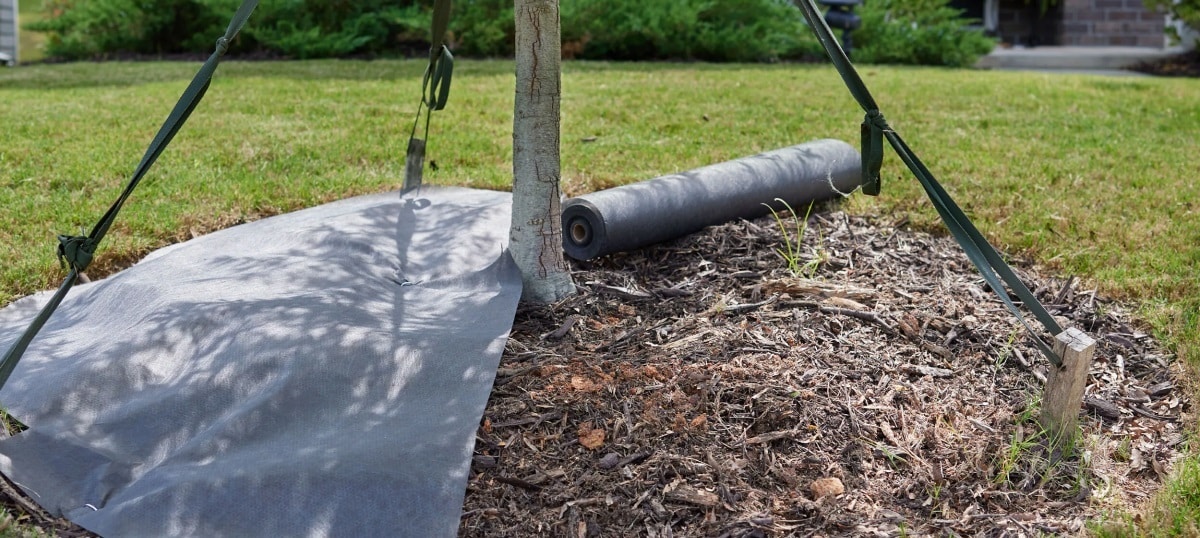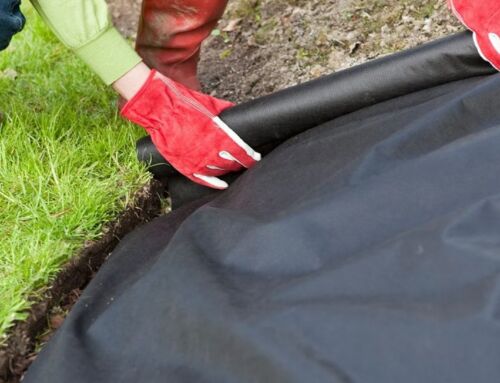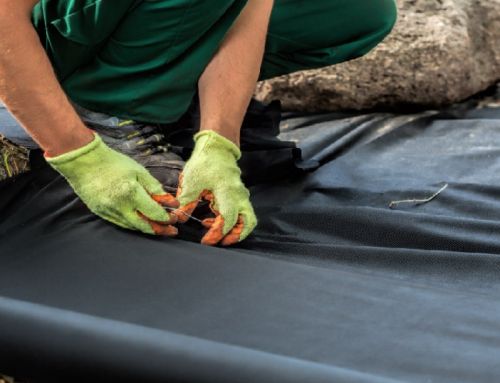Ever wondered why your neighbour’s garden looks green and healthy all year round while yours seems to struggle?
The secret might be lying beneath the surface.
If you’re fighting a never-ending battle against weeds, knowing how to win without dousing your yard in harsh chemicals is crucial. Instead of devoting your weekends to hours of back-breaking weed pulling, there is a simpler solution.
Enter landscape fabrics.
Landscape fabrics help suppress weeds without harsh chemicals but also conserve moisture and ensure your trees are in tip-top shape, all year round.
With Sydney’s unique climate and diverse plant life, knowing how to install landscape fabric is essential for any green thumb or landscape enthusiast.
This blog post will guide you through the crucial considerations, step-by-step instructions, and pro tips to ensure your trees not only survive but thrive. From selecting the right fabric to understanding the nuances of Sydney’s soil, we’ve got you covered.
Whether you’re a seasoned gardener looking to up your game or a beginner eager to transform your backyard into a verdant retreat, this article will provide all the knowledge you need.
Let’s dig in and get started.
What is Landscape Fabric?
Landscape fabric is a permeable material placed around plants and trees to promote a healthier garden.
Here’s how innovative residential landscape fabric solutions help support your outdoor space:
- Weed Suppression: Landscape fabric acts as a barrier, preventing weed seeds from finding soil to germinate in. This means less competition for resources, allowing your trees to thrive without the constant battle against invasive weed species.
- Moisture Conservation: Landscape fabric helps to retain soil moisture by reducing evaporation, ensuring that your trees have access to water even during dry spells.
- Soil Health: By allowing water and nutrients to penetrate while keeping the soil structure intact, landscape fabric supports the complex ecosystem beneath the surface. This promotes healthier soil, which is fundamental for root growth and nutrient uptake.
- Pest Reduction: Creating a physical barrier, it can prevent some soil-borne pests from reaching the tree roots, indirectly contributing to the overall health of your garden.
- Aesthetic Improvement: Beyond its practical benefits, landscape fabric can also enhance the visual appeal of your garden. It provides a clean canvas for mulch, gravel, or other decorative elements, making your garden look tidy and well-maintained.
Matching Landscape Fabric to Your Garden’s Needs
Before installing landscape fabric around your trees, it’s essential to assess your home or property’s specific needs and requirements.
Assessing Your Garden’s Needs
- Tree Types: Consider the types of trees you have. Different species may have varying requirements in terms of moisture, soil type, and susceptibility to pests and weeds. The landscape fabric you choose should accommodate these needs to ensure optimal growth conditions.
- Soil Condition: Evaluate the condition of your soil. Sydney’s diverse terrain means soil conditions can vary greatly from sandy in coastal areas to clay in inland regions. The fabric should allow for proper water and nutrient penetration to suit your soil type.
- Garden Layout: Reflect on the layout of your garden and how trees are integrated into it. The fabric should be installed in a way that complements your garden’s design, facilitating easy access for maintenance and harmonising with other elements like pathways or flower beds.
- Climate Considerations: Sydney’s climate, with its hot summers and mild winters, plays a significant role in garden maintenance. Choose a landscape fabric that withstands local weather conditions, ensuring durability and effectiveness throughout the seasons.
Pros and Cons of Landscaping Around Trees
Tools and Resources
Here’s a checklist to get you started:
- Landscape Fabric: Select a high-quality, permeable fabric that matches your garden’s specific needs. Consider environmental impact and longevity in your choice.
- Measuring Tape: For accurately measuring the area around your trees where the fabric will be laid.
- Scissors or a Utility Knife: To cut the fabric to the required size and shape.
- Garden Staples or Pins: These are used to secure the fabric to the ground, ensuring it stays in place.
- Mulch or Decorative Stones: To cover the fabric, providing an aesthetic finish and additional weed suppression.
- Gloves: Protect your hands during the installation process.
- Rake and Shovel: For preparing the site, including clearing weeds and smoothing the soil before laying down the fabric.
Tips for Choosing the Right Tools and Materials
Landscape Fabric Choices
Look for brands that offer UV resistance and are designed for the Australian climate to ensure durability against Sydney’s harsh sun.
Brands like Geofabrics and Landmaster provide options that are both eco-friendly and effective in weed suppression while allowing water and nutrients to reach your tree’s roots.
- Recommendation: Opt for a heavy-duty, woven fabric for areas with high weed pressure and a lighter, non-woven fabric for areas requiring more water permeability.
- Local Sourcing Tip: Visit local nurseries or landscaping supply stores in Sydney. These places often stock high-quality landscape fabrics suited to local conditions and can offer valuable advice on the best choice for your garden.
Garden Staples or Pins
Securing the fabric in place is crucial, and for that, you’ll need garden staples or pins. These should be made from durable, rust-resistant materials to withstand Sydney’s varied weather conditions.
- Recommendation: Choose galvanised steel staples for their durability and resistance to rust.
- Local Sourcing Tip: Hardware stores or garden centres in Sydney are your best bet for finding high-quality staples or pins. Buying in bulk can often save you money in the long run.
Mulch or Decorative Stones
Covering the landscape fabric with mulch or decorative stones not only enhances the aesthetic appeal of your garden but also adds an extra layer of weed protection. Choose materials that complement the overall design of your garden and the local landscape.
- Recommendation: For a natural look, native wood chips or bark mulch are excellent choices. For a more structured design, decorative stones or river pebbles can add elegance and contrast.
- Local Sourcing Tip: Source mulch from local tree services or landscapers to ensure it’s suitable for Sydney’s environment. Decorative stones can often be found at quarry outlets or landscaping supply stores, offering a wide range of local options.
Tools
Having the right tools at your disposal will make the installation process smoother and more efficient. A good pair of scissors or a utility knife is essential for cutting the fabric, while a durable rake and shovel will help prepare the site.
- Recommendation: Invest in high-quality, ergonomic tools that will last you through many gardening projects. Brands like Cyclone or Fiskars are well-regarded for their durability and ease of use.
- Local Sourcing Tip: Sydney’s local hardware stores and garden centres stock a wide range of gardening tools. Look out for sales or ask for professional-grade tools for the best value and performance.
A Step-by-Step Guide to Installing Landscape Fabric
Step 1: Prepare the Area
- Clear the Ground: Remove all weeds, debris, and stones from the area around your trees. This ensures the fabric sits smoothly against the soil.
- Safety Precaution: Wear gloves to protect your hands from sharp objects and potential irritants in the soil.
- Best Practice: Use a natural weed killer or manually remove weeds to avoid chemical residues in your garden.
Step 2: Measure and Cut the Fabric
- Measure the Area: Use a measuring tape to determine the amount of fabric needed, allowing for at least a 6-inch overlap at the seams.
- Cut the Fabric: Using scissors or a utility knife, cut the fabric to the required sizes.
- Safety Precaution: Always cut away from your body and keep your hands clear of the cutting line.
Step 3: Lay the Fabric
- Position the Fabric: Carefully place the landscape fabric around the base of your trees, ensuring it covers the entire area you prepared.
- Cut Slits for Trees: Make an X-shaped slit in the fabric for each tree, and gently fit it around the tree trunk.
- Best Practice: Overlap sections of fabric by at least 6 inches to prevent weeds from finding their way through gaps.
Step 4: Secure the Fabric
- Use Garden Staples: Anchor the fabric to the ground with garden staples, placing them at the edges and along seams at intervals of 1 to 2 feet.
- Safety Precaution: When hammering in the staples, watch your fingers to avoid accidental injury.
Step 5: Add Mulch or Stones
- Cover the Fabric: Spread a layer of mulch or decorative stones over the fabric. This not only looks great but also helps to keep the fabric in place.
- Best Practice: Aim for a layer about 2 to 3 inches thick to effectively suppress weeds and retain soil moisture.
Step 6: Water the Area
- Irrigate: Gently water the area to settle the mulch or stones and to start the moisture penetration through the fabric to the soil.
- Best Practice: Use a watering can or hose with a spray attachment to avoid disturbing the mulch or stones.
When to Call a Professional:
- If your garden has a complex layout, or steep slopes, or requires the removal of large trees or stumps, it might be time to call in a professional landscaper. Professionals can also offer advice on the best materials for your specific garden conditions and ensure the installation meets any local regulations.
The key to success lies in careful preparation, attention to detail, and a bit of elbow grease. With a bit of effort now, you’ll save countless hours of gardening in the future, leaving you more time to enjoy the beauty of your outdoor space.
Financial Planning for Your Landscape Project
| Component | Estimated Cost Range | Notes |
| Landscape Fabric | $50 – $200 | Costs vary based on fabric quality and garden size. |
| Garden Staples/Pins | $10 – $30 | Needed to secure the fabric. |
| Mulch/Decorative Stones | $50 – $300 | Depending on type and quantity. |
| Tools (if not owned) | $20 – $100 | Includes scissors, utility knife, rake, and shovel. |
| Professional Installation | $200 – $600 | Optional, based on hourly rates and project complexity. |
Tips for Budgeting and Cost Saving:
- Research and Compare Prices: Spend time comparing prices of landscape fabric and other materials from various suppliers to find the best deals.
- DIY to Save: Consider installing the landscape fabric yourself to save on labour costs. Many resources offer guidance, including tutorials and this blog post.
- Quality vs. Cost: Investing in higher-quality landscape fabric can be more cost-effective long term, as it will likely last longer and perform better, reducing the need for replacements.
- Bulk Purchases: Buying materials in bulk can often lead to cost savings, especially if you’re planning a large project or have multiple areas to cover.
- Seasonal Buying: Look out for sales during off-peak gardening seasons. Many garden centres offer discounts on materials during the winter months.
- Local Grants and Subsidies: While specific links cannot be provided here, Australian residents should explore local government websites for grants or subsidies related to sustainable gardening practices or water conservation efforts. These can often offset some of the costs associated with landscaping projects.
Ready to Transform Your Garden? Let’s Get Growing with Manna Landscapes!
Looking for a touch of professional expertise? Or, do you need a helping hand to bring your vision to life?
The experienced team at Manna Landscapes is here to help.
Our team of experienced and passionate landscaping professionals is dedicated to transforming Sydney gardens into breathtaking outdoor spaces.
Whether you need personalised advice to select the perfect landscape fabric, assistance with a complex installation, or a comprehensive quote to kickstart your project, we’re just a call or click away.
- Personalised Advice: Every garden is unique, and so are your landscaping needs. Reach out to us for tailored advice that considers your garden’s specific conditions and your personal preferences.
- Professional Installation: If the task seems daunting or you’re aiming for perfection, our team can handle the installation process from start to finish, ensuring optimal results that stand the test of time.
- No-Obligation Quote: Planning is key to any successful landscaping project. Contact Manna Landscapes for a detailed, no-obligation quote that respects your budget and your vision for your outdoor space.



